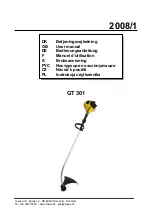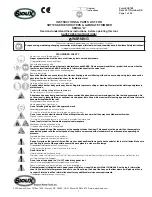
English |
17
– Turn the routing base
(2)
with the mark
to the symbol
and guide the drive unit slowly downwards until the
router bit touches the workpiece.
– Lock the clamping lever.
– Read the measuring value off the scale
(8)
and note it
down (zeroing). Add the required routing depth to this
value.
– Open the clamping lever and set the drive unit to the cal-
culated scale value.
– Turn the routing base with the mark
to the symbol
and lock the clamping lever back into place.
– Check the routing depth you have set by carrying out a
practical test and correct it if required.
For fine adjustment of the routing depth, proceed as follows:
– With the clamping lever
(10)
released, set the drive unit
with the mark
to the symbol .
– Set the required routing depth with the thumbwheel
(3)
.
– Lock the clamping lever.
Working Advice
u
Protect router bits against shock and impact.
Edge or profile routing (see figure G)
For edge and profile routing without a parallel guide, the
router bit must be fitted with a pilot pin or a ball bearing.
While it is switched on, guide the power tool towards the
workpiece from the side until the pilot pin or the ball bearing
of the router bit is touching the side of the workpiece edge
that you want to machine.
Guide the power tool along the workpiece edge. Pay atten-
tion that the router is positioned perpendicularly. Too much
pressure can damage the edge of the workpiece.
Routing with a parallel guide (see figure H)
You can fit a parallel guide
(17)
for when cutting parallel to
an edge.
Fit the parallel guide
(17)
to the routing base
(2)
using the
knurled screw
(16)
.
Set the required stop depth using the wing bolt on the paral-
lel guide
(18)
.
While it is switched on, guide the power tool along the work-
piece edge with a uniform feed and while applying lateral
pressure to the parallel guide.
Routing with a pilot (see figure I)
The pilot
(19)
helps when routing edges with router bits
without a pilot pin or ball bearing.
Fit the pilot to the routing base
(2)
using the nut
(16)
.
Guide the power tool along the workpiece edge with a uni-
form feed.
Lateral clearance:
To change the amount of material being
removed, you can adjust the lateral clearance between the
workpiece and the guide roller
(22)
on the pilot
(19)
.
Loosen the wing bolt
(20)
, set the lateral clearance you want
by turning the wing bolt
(21)
, then retighten the wing
bolt
(20)
.
Height:
Set the vertical alignment of the pilot according to
the router bit you are using and the thickness of the work-
piece you want to machine.
Loosen the nut
(16)
on the pilot, slide the pilot into the de-
sired position and retighten the bolt.
Fitting the base cover sleeve (see figure J)
Intensive use of the power tool will cause the routing base to
become hot. In this case, a base cover sleeve (accessory)
can be fitted to protect the hands.
Remove the clamping lever
(10)
.
Place the base cover sleeve
(23)
on the routing base
(2)
from above.
Reassemble the clamping lever again in such a manner that
the drive unit
(1)
is held securely in the routing base when
the clamping lever is locked.
Routing with the tilt base (see figures K–M)
The tilt base
(24)
is particularly suitable for flush routing of
laminated edges at hard-to-reach locations, for routing spe-
cial angles as well as for bevelling edges.
For edge routing using the tilt base, the router bit must be fit-
ted with a pilot pin or a ball bearing.
To fit the tilt base, follow the work steps in the correspond-
ing section (see "Fitting the routing base (see figure
page 16).
To achieve precise angles, the tilt base
(24)
is equipped with
adjustment notches in increments of 7.5°. The complete ad-
justment range is 75° (45° towards the front and 30° to-
wards the rear).
Loosen both wing bolts
(25)
.
Set the required angle using the scale
(26)
and tighten the
wing bolts
(25)
again.
Changing the guide plate (see figure N)
The side-handle guide plate
(30)
can be mounted in place of
the regular guide plate
(6)
. It features an additional
handle
(27)
and can be connected to a dust extraction sys-
tem.
– Unscrew the four cylinder screws on the underside of the
guide plate
(6)
and remove the guide plate.
– Screw the side-handle guide plate
(30)
to the base plate
with the fastening screws provided.
In order to connect a dust extraction system, an extraction
adapter
(30)
must be fitted to the side-handle guide
plate
(29)
.
– Screw the extraction adapter to the guide plate with the
two screws provided.
– Connect an extraction hose (dia. 35 mm) to the fitted ex-
traction adapter.
– To ensure optimum dust extraction, the extraction ad-
apter should be cleaned regularly.
For routing edges, the extraction guard
(28)
should also be
used.
– Fit the extraction guard between the side-handle guide
plate
(30)
and the extraction adapter
(29)
.
Bosch Power Tools
1 609 92A 57W | (01.04.2021)
Содержание GKF 600 Professional
Страница 3: ... 3 GKF 600 1 2 3 4 5 6 7 8 9 10 12 11 Bosch Power Tools 1 609 92A 57W 01 04 2021 ...
Страница 4: ...4 1 2 10 9 5 5 5 13 14 4 9 15 1 2 10 10 8 3 A B C D E F 1 609 92A 57W 01 04 2021 Bosch Power Tools ...
Страница 5: ... 5 16 17 18 16 19 20 21 22 23 2 10 10 1 24 24 G H I J K L Bosch Power Tools 1 609 92A 57W 01 04 2021 ...
Страница 6: ...6 24 25 25 26 27 28 29 30 31 10 M N O 1 609 92A 57W 01 04 2021 Bosch Power Tools ...
















































